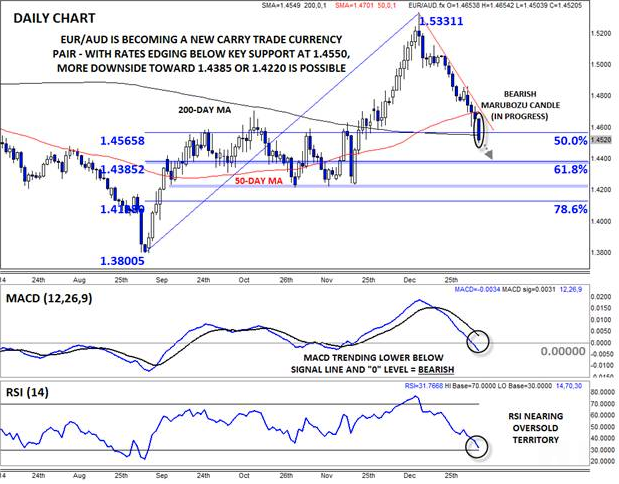One of the biggest casualties of the ongoing global low interest rate environment has been the carry trade, where traders sell a currency with a low interest rate and use the proceeds to buy a currency with a high interest rate. As we know, “high” interest yields have been hard to come by of late, limiting the appeal of carry trades the world over.
That said, there is no shortage of low-, or even negative-yielding funding currencies. Lately, traders have discovered the appeal of using the euro as a funding currency. Most short-term rates are negative throughout the Eurozone (indeed, German bund yields are negative going out to five years), meaning that it actually pays to borrow the euro and buy higher-yielding currencies against it.
Though interest rates are still subdued throughout the G10, currencies like the New Zealand and Australian dollars still offer some compensation for carry traders. As my colleague Chris Tedder noted earlier this week, “...even with the possibility that the RBA will cut the official cash rate to a new all-time low, it’s hard to look past the still-high yields on offer and their associated AAA rating, especially for investors based in countries/regions with questionable economies and low yielding bonds.” Thus, pairs like EUR/AUD and EUR/NZD have quietly become valid carry trade opportunities as investors price in QE from the ECB later this month.
Technical View: EUR/AUD
EUR/AUD has fallen precipitously over the past three weeks, but this drop has merely unwound the pair’s late-November and early-December surge. As we go to press, the pair appears to be breaking below critical support in the 1.4550-60 region, which represents the convergence of the 200-day MA and 50% Fibonacci retracement of the Q4 rally.
More immediately, the pair is showing a(n incomplete) Bearish Marubozu Candle* on the daily chart, suggesting strong selling pressure that could carry over into next week. Meanwhile, the MACD is trending lower below both its signal line and the “0” level, showing strong bearish momentum, though the nearly-oversold RSI indicator hints at a possible bounce down the road.
With two weeks still to go until the ECB’s highly-anticipated meeting, traders may continue to follow a “sell first, ask questions later” when it comes to the euro. As long as rates close today below the 1.4550-60 zone, bears may look to target the 61.8% Fibonacci retracement at 1.4385 next, followed by strong previous support in the 1.4220 region.
* A Marubozu candle is formed when prices open very near to one extreme of the candle and close very near the other extreme. Marubozu candles represent strong momentum in a given direction.

Source: FOREX.com
For more intraday analysis and market updates, follow us on twitter (@MWellerFX and @FOREXcom)
